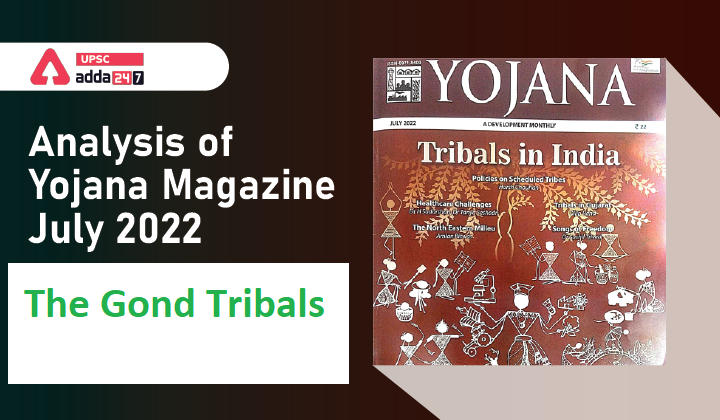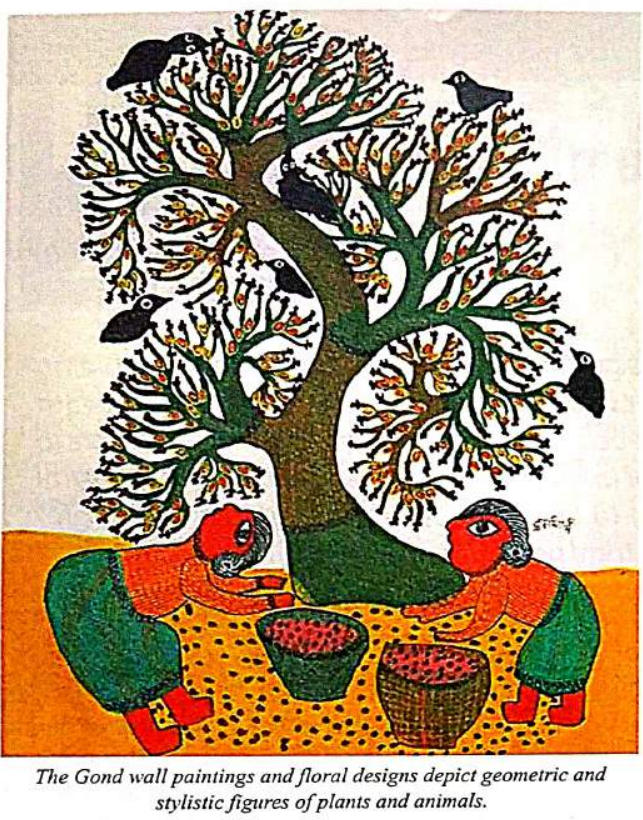Table of Contents
Yojana Magazine is a very important and indispensable source for UPSC Civil Services Exam Preparation. Here, we come with ”Analysis Of Yojana Magazine” which covers the monthly Yojana Magazine keeping in mind the demand of UPSC, particularly from the topics of important government schemes.
In ‘‘Analysis Of Yojana Magazine,” we cover each and every topic of the Yojana edition of a particular month and provide an easy-to-understand gist.
This topic-wise analysis is prepared from the July 2022 edition of the monthly Yojana Magazine.
The Gond Tribals: Introduction
- According to the 2011 Census, the tribals account for 109 million and represent 8.6% of the country’s total population.
- Of the total tribal population of the country, the Gonds are the largest in number.
- Gonds are seen in states across India such as Madhya Pradesh, Andhra Pradesh, Telangana, Chhattisgarh, Maharashtra, Bihar, Odisha, and Uttar Pradesh.
- There are several sub-tribes under the Gonds which share common ethnic origins.
- Various theories have been put forth to decode the origin of the Gonds as a race and one theory says that the name ‘Gond’ was given to them by other communities.
The Gond Tribals: How Old Are They?
- Many link the Adivasi Gond tribe to the Indus Valley civilisation, which flourished between 2500 B.C. and 1750 BC.
- The members of this community do not call themselves by that name, instead, they called and still call themselves “Koi” or “Koithur”.
The Gond Tribals: Sub Castes
- The Raj Gonds, Khatola, Madia, Dhur, Mokashi, Gayta, Koyas.
- Individuals born in a particular Sub Caste are known as: The Pradhans, Ojhas, Nagarchis, Dholis.
The Gond Tribals: Social Structure of the Gonds
- The social structure of the Gonds is one of the oldest and most unique systems created by their chief preceptor Pahandi Pari Kupar Lingo.
- They have about 750 paadings (clans) and 2250 paadi (totems) and initially 4 saga divisions.
- The Gond family is the smallest social unit. The Gond family is patrilineal and patrilocal. Only unmarried daughters are regarded as members of the family. They become a part of their husbands’ family post-marriage.
- Gonds use the term “pari” to express their group. A Gond clan is a unilateral group consisting of family members with the same clan name. The members of the clan are believed to be descended from a common ancestor.
- There are various sub-castes which include the Pardhans, Ojhas, Nagarchis, Dholis, Raj Gonds, Khatola Gonds, Madia Gonds, Dhur Gonds, Dadve Gonds, Mokashi Gonds, Ciaita Gonds, Koyas, etc.
- Marriage is forbidden among blood relatives, however, marriage among the children of maternal uncles and paternal aunts is common.
- Most of the domestic work is centred around women. The husband consults the wife in all the major conflicts within the family. However, women are excluded from certain rituals.
The Gond Tribals: The religious life of Gonds
- Like most of the tribes, Gonds believe firmly in myths and omens.
- Gonds also believe in life after death, ancestor worship, sacrifice, and sacred plants and animals.
- The priests among the Gonds are called Pujar, Bhagat, and Baiga.
- The important festivals of Gonds include Akkari, Jiwati, Pola, Diwali Nawo tindana, Dussera, Phag or Shimga.
The Gond Tribals: Important cultural aspects of Gonds
- Flowers of the mohuwa are extensively used by Gonds in their diet. The liquor prepared using distilled flowers of Mohuwa is an important part of their religious and social culture.
- Gonds tattoo their bodies and are seen as true jewellery that remains with them even after their death.
- The songs of Gonds have different ragas for different seasons and occasions. The main dance forms are Karma, Ri-na, Ri-lo, Re-la, SelaDanda (stick), Mandari, Hulki, and Suwa, etc.
- Songs and dances are accompanied by various musical instruments like drums, flute, cymbals and others.
- Gonds are said to be experts in arts and crafts. They are also experts in wall paintings and floral designs with geometric designs and stylistic figures of plants and animals. The geometric and symbolic designs are carved on walls and doors, on combs and tobacco cases.
Gotul
- Gotul is a traditional institution of the Gonds that was used to inculcate a sense of discipline and cooperation among its members.
- It was the centre of learning and inculcated integrity and uniqueness among all the members of the Gotul.
- It helped members learn about idioms, wisdom sayings, ecology and forestry, medicines and herbals, hunting and fishing.
Gondi Language
- Gondi is a proto Dravidian language and gives enough scope for studying the pictographs though its root morphemes.
- Gonds, when communicating with outsiders, use a colloquial type of Hindi, known as Chhattisgarhi.




 TSPSC Group 1 Question Paper 2024, Downl...
TSPSC Group 1 Question Paper 2024, Downl...
 TSPSC Group 1 Answer key 2024 Out, Downl...
TSPSC Group 1 Answer key 2024 Out, Downl...
 UPSC Prelims 2024 Question Paper, Downlo...
UPSC Prelims 2024 Question Paper, Downlo...
